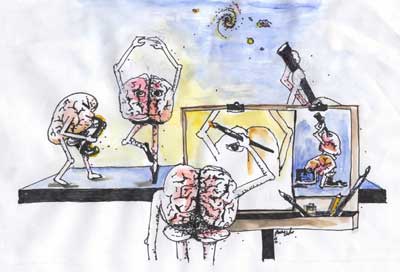 From Serendip | SCIENCE AS EXPLORATION INSTITUTE 2001 | 
|
Oscillations and Waves
An Inquiry-Based Teaching Module
developed by Elizabeth McCormack, Department of Physics, Bryn Mawr College
Scientific Content. This module is meant to introduce students to wave phenomenon and the manner is which waves are characterized including the concepts of transverse and longitudinal waves, wave amplitudes, frequency and velocity. The concepts of standing waves and wave interference are also explored.
So what? Change, especially cyclic change, can be viewed as repetitious behavior. The orbit of planets, the business cycle of the economy, the population of wolves on an island, all can exhibit oscillatory or repetitious behavior. Wave motion is the simplest example of such repetitive motion. Thus understanding waves allows us to make sense of these diverse phenomena in terms of quantities like the amplitude and frequency of the repeating behavior. In addition, fundamental physical waves occur in nature, for example, water waves, sound waves, and electromagnetic waves (radio and light). Wave motion is a ubiquitous way in which energy and momentum are transported. Finally, physical wave phenomena form the basis of many new and old technologies in use today, e.g., cellular phones, musical instruments, microwave ovens, etc.
Assessment/Evaluation. For this module, we will use oral Concept Tests to get feedback on how well students learned the material presented in the activities. This assessment has the advantage of giving a teacher feedback immediately in the classroom so they can adjust to what students are getting quickly and what they are struggling with in real time, rather than waiting to get that feedback on a written exam. Also this technique fosters valuable peer teaching and learning experiences among the students.
Logistics of transference to K-12. This module could be adapted for Elementary or Middle School, or even High School as a fun refresher. What would such a module look like for students at these different levels?
Equipment and supplies. Slinkys for traveling pulses both longitudinal and transverse, (the longer the better to avoid complications of reflections). Hose or rope for transverse standing waves. Dominoes for longitudinal waves. A timing device or clock.
The Five E’s:
Engage Explore Explain Elaborate Evaluate
Engage: The Wave
Explore and Explain:
It is important to distinguish the vibrational motions of a particle of the medium (the substance through which the wave travels) and the movement of the wave itself. Tie a ribbon to a piece of your hose or your slinky to highlight this distinction.
Use the following to demonstrate that the vibrating motion of a piece of the medium is either parallel or perpendicular to the motion of the wave.
Explore and explain wave amplitude, wave speed, wave frequency and wave length.
Transverse waves (Slinkys and Hose)
Water waves and radiation (light, radio, micro-) waves
Longitudinal waves (Slinkys)
Sound waves
Consider the transfer of energy and momentum
We see a bump or a compression traveling down the medium. We could call them disturbances which leads to a good definition of a wave:
A wave is a disturbance that travels through a medium and transfers energy without actually transferring matter.
Elaborate:
Superposition of waves and wave interference. Have students explore concepts of destructive and constructive interference
Two waves travel in opposite directions on your rope, hose or slinky ( which works best?) What happens. The two disturbances travel right through each other. Try positive and negative pulses. Draw what happens before they pass through each other, when they are on top of each other and after they pass through each other. What happens to the energy? Does it vanish? Hint -- what are the particles of the hose or rope doing?
Consider special waves:
Continuous harmonic waves. Have your students try to make continuous waves, with a fixed wavelength and frequency.
Standing waves:
Have your students make standing waves by using the wave reflection from the wall. Can they get more than one node?
A slinky or rope has only one significant dimension, its length. Interference effects get more interesting in two or three dimensions, e.g. 2-D water waves in a pond, or 3-D sound waves in an auditorium.
Example of 3-D standing waves in a boxes--Microwave ovens
With the materials at hand, come up with a way to demonstrate the connection between an oscillation and the wave concept. How are they related?
Evaluate: Concept Tests
For examples see galileo@deas.harvard.edu and here